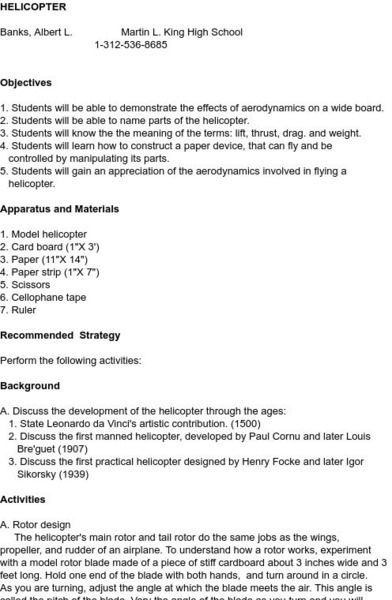Smithsonian Institution
National Air and Space Museum: Wright Brothers: Embracing the Impossible [Pdf]
In this lesson, students explore primary resources to see what people who lived in the early age of flight felt about this innovation. They then compare that response to that towards an invention of today.
Center for Innovation in Engineering and Science Education, Stevens Institute of Technology
Ciese Navigational Vectors
For this project, students use real time data to learn how pilots navigate when they fly. Students go through a series of lessons on vectors, weather maps and flight tracking, then take a pilot's test where they apply what they have...
C-SPAN
C Span Classroom: Lesson Plan: Examples of Regulatory Agencies
In this lesson, students learn about the costs and benefits of regulations and regulatory agencies. It includes nine video clips.
TryEngineering
Try Engineering: Engineered Sports
Learners work in teams to investigate how aerospace engineering relates to sports, especially golf ball design and the physics of bounce. They use this information to determine whether these aerospace principles can be applied to...
Council for Economic Education
Econ Ed Link: Transportation: They Say We Had a Revolution (Part 1)
Advancements in transportation have played a key role in the growth of our nation. U.S.government policies have also had a considerable impact on the development of transport as we know it today. In this series of three lessons, the...
Discovery Education
Discovery Education: Inventors and Inventions 2: Air and Space
After discussing important flying inventions, students explore technological design by making paper airplanes.
Council for Economic Education
Econ Ed Link: Transportation: They Say We Had a Revolution (Part 3)
Advancements in transportation have played a key role in the growth of our nation. U.S. government policies have also had a considerable impact on the development of transport as we know it today. In this series of three lessons, the...
Alabama Learning Exchange
Alex: Let's Calculate Flight!
Learners will use stop watches to help understand elapsed time when they fly paper airplanes through the air. Students will then move on to using clocks. Learners will work out elapsed time word problems using made up flight schedules.
Alabama Learning Exchange
Alex: Building a Paper Airplane Using Bernoulli's Principle
This is a culmination activity used after students have studied Bernoulli's Principle as part of a unit on forces and fluids. Students will use the Internet, textbooks, library resources and their cooperative learning group to design...
PBS
Pbs Learning Media: Amelia Earhart: Aviator, Record Breaker, and Activist
Through two primary source activities and a short video, students will learn about Earhart's passion for flying and determination to succeed as a female aviator.
Smithsonian Institution
Smithsonian Learning Lab: Stories of the Wrights' Flights
This lesson plan has students read primary materials from the Smithsonian collection written by the Wright brothers, and compare and contrast them to secondary sources, such as newspaper stories from the next day. There is background...
PBS
Pbs Teachers: Scientific American: Flying Free: Winging It
Explore flight and the science behind lift and wing shape by creating two paper airplanes - a monoplane glider and a ring-wing glider.
TeachEngineering
Teach Engineering: Can You Take the Pressure?
This lesson introduces students to the concept of air pressure. Students will explore how air pressure creates force on an object. They will study the relationship between air pressure and the velocity of moving air.
TeachEngineering
Teach Engineering: May the Force Be With You: Thrust
In this lesson, young scholars will study how propellers and jet turbines generate thrust. This lesson focuses on Isaac Newton's 3rd Law of Motion, which states that for every action there is an equal and opposite reaction.
University Corporation for Atmospheric Research
Ucar: Learn to Fly! Uav First Flight
Students begin to learn basics of flying UAVs/drones. This simple initial flight includes a take-off, hovering at different heights, and landing.
PBS
Pbs Learning Media: Higher and Faster
In this interactive lesson, students will explore the social factors, economic factors and engineering innovations that drive higher and faster commercial flights.
The Franklin Institute
Franklin Institute Online: Working Wing
This lesson plan provides a brief demonstration of how airplane wings lift a heavy airplane into the air. This activity would be an excellent example of how science and technology have positively impacted our lives. Prediction and...
Discovery Education
Discovery Education: Rome's Influence
A lesson plan which has students understanding the impact that Rome had on history, from things as diverse as city planning to our everyday vocabulary.
Science and Mathematics Initiative for Learning Enhancement (SMILE)
Smile: Lab Activity: Helicopter
The Illinois Institute of Technology lets students investigate the aerodynamics of a helicopter, focusing on the variables which effect the lift, thrust, drag, and weight. Students investigate the effects of aerodynamics on a wide board.
Science and Mathematics Initiative for Learning Enhancement (SMILE)
Smile: Lab Work: Come Fly With Me
This site by the Illinois Institute of Technology lets students use a vacuum cleaner hose, ping pong balls, straws and other materials to investigate the effect of moving air upon the surfaces which it hits. Principles are applied as...
Other popular searches
- Aviation and Aerospace
- Aviation History
- Aviation Topics
- Aviation Powerpoint
- Applied Math for Aviation
- Careers in Aviation
- Aviation Lesson Plans
- History of Aviation
- Flight, Aviation
- Aviation Classroom Projects
- Aviation Industry
- Aviation Pioneers


![National Air and Space Museum: Wright Brothers: Embracing the Impossible [Pdf] Lesson Plan National Air and Space Museum: Wright Brothers: Embracing the Impossible [Pdf] Lesson Plan](https://d15y2dacu3jp90.cloudfront.net/images/attachment_defaults/resource/large/FPO-knovation.png)









